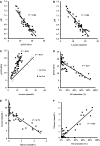Ischemic priapism as a model of exhausted metabolism
- PMID: 30916476
- PMCID: PMC6436141
- DOI: 10.14814/phy2.13999
Ischemic priapism as a model of exhausted metabolism
Abstract
In vivo metabolic studies typically concern complex open systems. However, a closed system allows better assessment of the metabolic limits. Ischemic priapism (IP) constitutes a special model of the compartment syndrome that allows direct sampling from a relatively large blood compartment formed by the corpora cavernosa (CC). The purpose of our study was to measure metabolic changes and the accumulation of end products within the CC during IP. Blood gas and biochemical analyses of aspirates of the CC were analyzed over an 8-year period. Mean ± SD pH, pCO2 , pO2 , O2 -saturation, lactate, and glucose of the aspirated blood were determined with a point-of-care analyzer. Forty-seven initial samples from 21 patients had a pH of 6.91 ± 0.16, pCO2 of 15.3 ± 4.4 kPa, pO2 of 2.4 ± 2.0 kPa, and an O2 -saturation of 19 ± 24% indicating severe hypoxia with severe combined respiratory and metabolic acidosis. Glucose and lactate levels were 1.1 ± 1.5 and 14.6 ± 4.8 mmol/L, respectively. pH and pCO2 were inversely correlated (R2 = 0.86; P < 0.001), glucose and O2 -saturation were positively correlated (R2 = 0.83; P < 0.001), and glucose and lactate were inversely correlated (R2 = 0.72; P < 0.001). The positive correlation of CO2 and lactate (R2 = 0.69; P < 0.001) was similar to that observed in vitro, when blood was titrated with lactic acid. The observed combined acidosis underscores that IP behaves as a closed system where severe hypoxia and glycopenia coexist, indicating that virtually all energy reserves have been consumed.
Keywords: Corpus cavernosum; glycopenia; lactic acidosis; priapism; respiratory acidosis.
© 2019 The Authors. Physiological Reports published by Wiley Periodicals, Inc. on behalf of The Physiological Society and the American Physiological Society.
Conflict of interest statement
None.
Figures


References
-
- Doro, C. J. , Sitzman T. J., and O'Toole R. V.. 2014. Can intramuscular glucose levels diagnose compartment syndrome? J. Trauma Acute Care Surg. 76:474–478. - PubMed
-
- Guyton, M. C. , and Hall J. E.. 2016. Chapter 31: acid‐base regulation Pp. 409–426 in Guyton A. C. and Hall J. E., eds. Medical physiology, 13th ed Elsevier, Philadelphia, PA.
-
- Ichihara, K. , Haga N., and Abiko Y.. 1984. Is ischemia‐induced pH decrease of dog myocardium respiratory or metabolic acidosis? Am. J. Physiol. 246(5 Pt 2):H652–H657. - PubMed
-
- Kim, N. N. , Jong Kim J., Hypolit J., Garcia‐Diaz J. F., Broderick G. A., Tornheim K., et al. 1996. Altered contractility of rabbit penile corpus cavernosum smooth muscle by hypoxia. J. Urol. 155:772–778. - PubMed
MeSH terms
Substances
LinkOut - more resources
Full Text Sources

